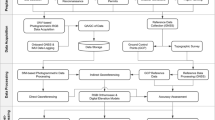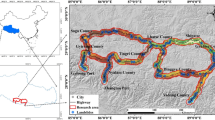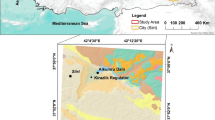Abstract
Conventional, manual methods of surveying unstable bedrock promontories on high and steep slopes are very risky and time-consuming due to problems regarding steep terrain and traffic inconvenience. This paper describes an unmanned aerial vehicle (UAV)-based method for the identification of unstable bedrock promontories. The first step is the spatial position identification of bedrock promontories, which is implemented by processing point cloud models with the one-class support vector machine (OC-SVM) and clustering algorithm. The next step is the preliminary stability assessment of bedrock promontories. Kinematic analysis by mapping the orientations of penetrative discontinuities within bedrock promontories is used to evaluate the stability. The applicability of the method is assessed using the point cloud model of the bank slopes of the Lianghekou Hydropower Project. The results show that effective identification, and preliminary stability assessment of bedrock promontories can be carried out using UAV photogrammetry.

















Similar content being viewed by others
References
Barlow J, Gilham J, Ibarra Cofrã I (2017) Kinematic analysis of sea cliff stability using UAV photogrammetry. Int J Remote Sens 38:2464–2479
Beretta F, Rodrigues AL, Peroni RL, Costa JFCL (2019) Automated lithological classification using UAV and machine learning on an open cast mine. Appl Earth Sci 128:79–88
Cazals F, Pouget M (2005) Topology driven algorithms for ridge extraction on meshes. [Research Report] RR-5526, INRIA. 2005, 29
Chudzian P (2011) Radial basis function kernel optimization for pattern classification. In, Berlin, Heidelberg, Computer Recognition Systems 4. Springer, Berlin Heidelberg, pp 99–108
Fanti R, Gigli G, Lombardi L, Tapete D, Canuti P (2013) Terrestrial laser scanning for rockfall stability analysis in the cultural heritage site of Pitigliano (Italy). Landslides 10:409–420
Fazio NL, Perrotti M, Andriani GF, Mancini F, Rossi P, Castagnetti C, Lollino P (2019) A new methodological approach to assess the stability of discontinuous rocky cliffs using in-situ surveys supported by UAV-based techniques and 3-D finite element model: a case study. Engineering Geology 260:105205
Ferrero AM, Forlani G, Roncella R, Voyat HI (2009) Advanced geostructural survey methods applied to rock mass characterization. Rock Mech Rock Eng 42:631–665
Giordan D, Adams MS, Aicardi I et al (2020) The use of unmanned aerial vehicles (UAVs) for engineering geology applications[J]. Bull Eng Geol Env 79:3437–3481
Harwin S, Lucieer A (2012) Assessing the accuracy of georeferenced point clouds produced via multi-view stereopsis from unmanned aerial vehicle (UAV) imagery. Remote Sensing 4:1573–1599
Hennig T, Wang W, Feng Y, Ou X, He D (2013) Review of Yunnan’s hydropower development. Comparing small and large hydropower projects regarding their environmental implications and socio-economic consequences. Renew Sustain Energy Rev 27:585–595
Hoek E, Bray J (1981) Rock slope engineering, 3rd edn. Institution of Mining and Metallurgy, London, UK
Kriegel H-P, Kröger P, Sander J, Zimek A (2011) Density-based clustering. Wiley Interdisciplinary Reviews: Data Mining and Knowledge Discovery 1:231–240
Lucieer A, Jong SMd, Turner D (2014) Mapping landslide displacements using structure from motion (SfM) and image correlation of multi-temporal UAV photography. Progress in Physical Geography: Earth and Environment 38:97–116
Mayr A, Rutzinger M, Bremer M, Oude Elberink S, Stumpf F, Geitner C (2017) Object-based classification of terrestrial laser scanning point clouds for landslide monitoring. Photogram Rec 32:377–397
Menegoni N, Giordan D, Perotti C, Tannant DD (2019) Detection and geometric characterization of rock mass discontinuities using a 3D high-resolution digital outcrop model generated from RPAS imagery – Ormea rock slope. Ital Eng Geol 252:145–163
Niethammer U, James MR, Rothmund S, Travelletti J, Joswig M (2012) UAV-based remote sensing of the Super-Sauze landslide: Evaluation and results. Eng Geol 128:2–11
Pauly M, Gross M, and Kobbelt LP (2002) Efficient simplification of point-sampled surfaces. In Proceedings of the conference on Visualization ’02 (VIS ’02). IEEE Computer Society, USA, 163–170
Pipaud I, Lehmkuhl F (2017) Object-based delineation and classification of alluvial fans by application of mean-shift segmentation and support vector machines. Geomorphology 293:178–200
Riquelme AJ, Abellán A, Tomás R, Jaboyedoff M (2014) A new approach for semi-automatic rock mass joints recognition from 3D point clouds. Comput Geosci 68:38–52
Schölkopf B, Platt JC, Shawe-Taylor J, Smola AJ, Williamson RC (2001) Estimating the support of a high-dimensional distribution. Neural Comput 13:1443–1471
Slob S, van Knapen B, Hack R, Turner K, Kemeny J (2005) Method for automated discontinuity analysis of rock slopes with three-dimensional laser scanning. Transp Res Rec 1913:187–194
Tonini M, Abellan A (2014) Rockfall detection from terrestrial LiDAR point clouds: a clustering approach using R. J Spat Inf Sci 2014:95–110
Tonkin TN, Midgley NG (2016) Ground-control networks for image based surface reconstruction: an investigation of optimum survey designs using UAV derived imagery and structure-from-motion. Photogramm Remote Sens 8:786
Torrero L, Seoli L, Molino A, Giordan D, Manconi A, Allasia P, Baldo M The use of micro-UAV to monitor active landslide scenarios. In, Cham, 2015. Engineering Geology for Society and Territory - Volume 5. Springer International Publishing, pp 701–704
Vasuki Y, Holden E-J, Kovesi P, Micklethwaite S (2014) Semi-automatic mapping of geological Structures using UAV-based photogrammetric data: an image analysis approach. Comput Geosci 69:22–32
Verhoeven G (2011) Taking computer vision aloft – archaeological three-dimensional reconstructions from aerial photographs with photoscan. Archaeol Prospect 18:67–73
Wang MX, Huang D, Wang G, Li DQ (2020) SS-XGBoost: a machine learning framework for predicting newmark sliding displacements of slopes. J Geotech Geoenviron Eng 146:04020074
Zhang Y-H, Geng G-H, Wei X-R (2015) Valley-ridge feature extraction from point clouds. Opt Precis Eng 23:310–318
Funding
This research was supported by the Joint Fund of the Natural Science Foundation of China and Yalong River Hydropower Development Co., Ltd. (grant no. U1765106).
Author information
Authors and Affiliations
Corresponding author
Rights and permissions
About this article
Cite this article
Cui, W., Wang, Xh., Zhang, Gk. et al. Identification of unstable bedrock promontory on steep slope based on UAV photogrammetry. Bull Eng Geol Environ 80, 7193–7211 (2021). https://doi.org/10.1007/s10064-021-02333-z
Received:
Accepted:
Published:
Issue Date:
DOI: https://doi.org/10.1007/s10064-021-02333-z




